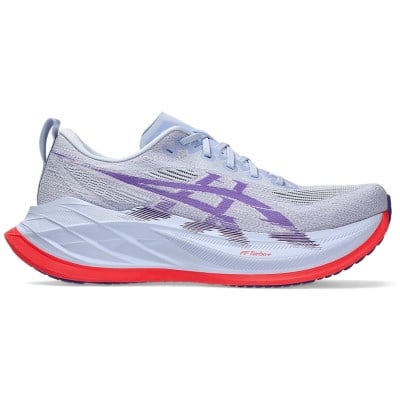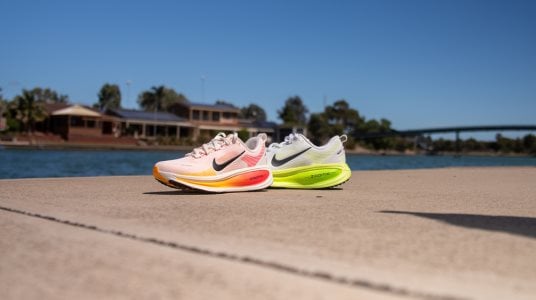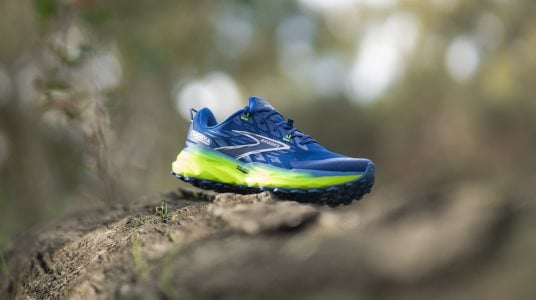Asics Superblast 2: Refined Performance

Superblast 2: Quick Facts
Weight:
- Unisex: 249g US M 9
Use:
- Verstatile daily trainer
- Long run
- Race shoe for some runners
Price:
- $319.99 AUD
Stack Height & Drop:
- 45.7mm heel / 37.5mm forefoot
- 8mm drop
Favourite Features:
- FF Turbo + midsole foam
- Class leading cushion to weight ratio
Release Date:
- July 5, 2024
Asics Superblast 1 vs 2
The Asics Superblast series quickly became one of the most sought-after super trainers when it launched in 2022. The versatility it offered made it a favourite among the running community and the Superblast was my personal go-to for long runs. It provided excellent protection underfoot, staying lightweight and responsive enough to pick up the pace when needed. We also found the combination of cushioning, speed, and stability made it a great option for first-time marathoners who are out on the road for 3-5 hours wanting a speedy, yet stable ride.
Asics has made some refinements with the Superblast 2, but don’t worry—it’s still very much a Superblast! Let’s break down the key updates in the upper, midsole, and outsole below.
Upper: enhanced premium fit
The Superblast 1 came with a breathable mesh upper, which kept the shoe light and well-ventilated. While it provided a snug, secure fit, we did notice some feedback from runners with broader feet who felt the midfoot was a little tight. The collar and tongue were padded for comfort, though I personally felt a bit more flexibility could’ve made the upper even better, especially for different foot shapes.
With the Superblast 2, Asics made a nice update to the upper. It's new adaptive, stretchy woven knit material offers a more accommodating fit for a wider variety of foot shapes. Personally, I find the updated upper not only more flexible but also a bit more premium in feel. It’s been more comfortable for me, especially on longer runs, where comfort is super important.

Midsole: where the magic happens
The midsole in the Superblast 1 was powered by a top layer of FF Turbo foam and a bottom layer of FF Blast+ foam, giving the shoe its signature cushioned and bouncy feel. What continues to impress me about the Superblast 2 is how consistent it feels over longer runs and how lightweight it is given such a large stack height.
In the Superblast 2, Asics has kept the dual-layer setup but swapped in FF Turbo + foam, which first appeared in this year's Metaspeed Paris range. The midsole update makes the Superblast 2 slightly softer, bouncier, and more dynamic underfoot. From my own experience, it also translates into a smoother, more comfortable ride, especially at easier paces which is a subtle improvement over an already fantastic midsole in Superblast 1.

Outsole: no more rocks
The outsole of the Superblast 1 featured lightweight rubber that provided decent traction on roads and light trails. I was honestly surprised by how durable it was for such a performance-focused shoe. I ran over 600 km in two pairs, and they held up remarkably well. That said, one common issue was the rocks and debris that would get stuck in the cutouts within the midsole—a bit of a nuisance on my runs.
We are happy to see that Asics have reinforced the outsole in key areas, added extra lugs for traction, and filled in those midsole cutouts. I’ve yet to deal with any debris getting stuck in the Superblast 2, which has been a small, but welcome improvement.

Nathan's final thoughts
The Asics Superblast 2 builds on everything we loved about the Superblast 1, while updating some of the areas that had room for improvement. The upper is now more premium and adaptive, the midsole delivers an even softer, bouncier ride, and the outsole is grippier. If you liked the lightweight versatility of the first Superblast 1, you’ll love these subtle refinements in version 2.
Whether you’re prepping for a marathon, looking for a versatile long-run shoe, or seeking a do-it-all option, the Superblast 2 continues to provide the protection, speed, and comfort that made the series so popular in the running community.
About the author
Nathan Pope - Runner and Shoe Nerd
I'm really passionate about running footwear and how shoes can be used as a tool to get the best of your running, whether that be general fitness or performance.
My favourite event is the marathon. I feel as though the marathon is the ultimate test both physically and mentally! It requires careful planning both within the race and during the training block and it can be super satisfying when it comes together on race day.



